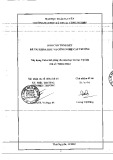
This Provisional PDF corresponds to the article as it appeared upon acceptance. Fully formatted
PDF and full text (HTML) versions will be made available soon.
A modified Mann iterative scheme by generalized f-projection for a countable
family of relatively quasi-nonexpansive mappings and a system of generalized
mixed equilibrium problems
Fixed Point Theory and Applications 2011, 2011:104 doi:10.1186/1687-1812-2011-104
Siwaporn Saewan (si_wa_pon@hotmail.com)
Poom Kumam (poom.kum@kmutt.ac.th)
ISSN 1687-1812
Article type Research
Submission date 23 July 2011
Acceptance date 21 December 2011
Publication date 21 December 2011
Article URL http://www.fixedpointtheoryandapplications.com/content/2011/1/104
This peer-reviewed article was published immediately upon acceptance. It can be downloaded,
printed and distributed freely for any purposes (see copyright notice below).
For information about publishing your research in Fixed Point Theory and Applications go to
http://www.fixedpointtheoryandapplications.com/authors/instructions/
For information about other SpringerOpen publications go to
http://www.springeropen.com
Fixed Point Theory and
Applications
© 2011 Saewan and Kumam ; licensee Springer.
This is an open access article distributed under the terms of the Creative Commons Attribution License (http://creativecommons.org/licenses/by/2.0),
which permits unrestricted use, distribution, and reproduction in any medium, provided the original work is properly cited.

A modified Mann iterative scheme by
generalized f-projection for a
countable family of relatively
quasi-nonexpansive mappings and a
system of generalized mixed
equilibrium problems
Siwaporn Saewan∗1and Poom Kumam∗1,2
1Department of Mathematics, Faculty of Science
King Mongkut’s University of Technology Thonburi (KMUTT)
Bangmod, Bangkok 10140, Thailand
2Centre of Excellence in Mathematics, CHE
Si Ayutthaya Rd., Bangkok 10400, Thailand
∗Corresponding authors: si wa pon@hotmail.com
Email address:
PK: kumampoom@hotmail.com; poom.kum@kmutt.ac.th
Abstract
The purpose of this paper is to introduce a new hybrid projection
method based on modified Mann iterative scheme by the general-
ized f-projection operator for a countable family of relatively quasi-
nonexpansive mappings and the solutions of the system of generalized
mixed equilibrium problems. Furthermore, we prove the strong con-
vergence theorem for a countable family of relatively quasi-nonexpansive
mappings in a uniformly convex and uniform smooth Banach space.
Finally, we also apply our results to the problem of finding zeros of
B-monotone mappings and maximal monotone operators. The results
1

presented in this paper generalize and improve some well-known re-
sults in the literature.
Keywords: The generalized f-projection operator; relatively quasi-
nonexpansive mapping; B-monotone mappings; maximal monotone
operator; system of generalized mixed equilibrium problems.
2000 Mathematics Subject Classification: 47H05; 47H09; 47H10.
1 Introduction
The theory of equilibrium problems, the development of an efficient and im-
plementable iterative algorithm, is interesting and important. This theory
combines theoretical and algorithmic advances with novel domain of applica-
tions. Analysis of these problems requires a blend of techniques from convex
analysis, functional analysis, and numerical analysis.
Equilibrium problems theory provides us with a natural, novel, and uni-
fied framework for studying a wide class of problems arising in economics,
finance, transportation, network, and structural analysis, image reconstruc-
tion, ecology, elasticity and optimization, and it has been extended and gen-
eralized in many directions. The ideas and techniques of this theory are being
used in a variety of diverse areas and proved to be productive and innovative.
In particular, generalized mixed equilibrium problem and equilibrium prob-
lems are related to the problem of finding fixed points of nonlinear mappings.
Let Ebe a real Banach space with norm k · k,Cbe a nonempty closed
convex subset of Eand let E∗denote the dual of E. Let {θi}i∈Λ:C×C→R
be a bifunction, {ϕi}i∈Λ:C→Rbe a real-valued function, and {Ai}i∈Λ:
C→E∗be a monotone mapping, where Λ is an arbitrary index set. The
system of generalized mixed equilibrium problems is to find x∈Csuch that
θi(x, y) + hAix, y −xi+ϕi(y)−ϕi(x)≥0, i ∈Λ,∀y∈C. (1.1)
If Λ is a singleton, then problem (1.1) reduces to the generalized mixed equi-
librium problem is to find x∈Csuch that
θ(x, y) + hAx, y −xi+ϕ(y)−ϕ(x)≥0,∀y∈C. (1.2)
The set of solutions to (1.2) is denoted by GMEP(θ, A, ϕ), i.e.,
GMEP(θ, A, ϕ) = {x∈C:θ(x, y)+hAx, y−xi+ϕ(y)−ϕ(x)≥0,∀y∈C}.
(1.3)
2

If A≡0, the problem (1.2) reduces to the mixed equilibrium problem for θ,
denoted by MEP(θ, ϕ) is to find x∈Csuch that
θ(x, y) + ϕ(y)−ϕ(x)≥0,∀y∈C. (1.4)
If θ≡0, the problem (1.2) reduces to the mixed variational inequality of
Browder type, denoted by V I(C, A, ϕ) is to find x∈Csuch that
hAx, y −xi+ϕ(y)−ϕ(x)≥0,∀y∈C. (1.5)
If A≡0 and ϕ≡0 the problem (1.2) reduces to the equilibrium problem for
θ, denoted by EP(θ) is to find x∈Csuch that
θ(x, y)≥0,∀y∈C. (1.6)
If θ≡0, the problem (1.4) reduces to the minimize problem, denoted by
Argmin(ϕ) is to find x∈Csuch that
ϕ(y)−ϕ(x)≥0,∀y∈C. (1.7)
The generalized mixed equilibrium problems include fixed point problems,
optimization problems, variational inequality problems, Nash equilibrium
problems, and the equilibrium problems as special cases. Moreover, the above
formulation (1.5) was shown in [1] to cover monotone inclusion problems, sad-
dle point problems, variational inequality problems, minimization problems,
optimization problems, vector equilibrium problems, and Nash equilibria in
noncooperative games. In other words, the GMEP(θ, A, ϕ), MEP(θ, ϕ) and
EP(θ) are an unifying model for several problems arising in physics, engi-
neering, science, optimization, economics, etc. Many authors studied and
constructed some solution methods to solve the GMEP(θ, A, ϕ), MEP(θ, ϕ),
EP(θ) [1–16, and references therein].
Let Cbe a closed convex subset of Eand recall that a mapping T:C→C
is said to be nonexpansive if
kT x −T yk ≤ kx−yk,∀x, y ∈C.
A point x∈Cis a fixed point of Tprovided T x =x. Denote by F(T) the
set of fixed points of T, that is, F(T) = {x∈C:T x =x}.
As we know that if Cis a nonempty closed convex subset of a Hilbert
space Hand recall that the (nearest point) projection PCfrom Honto C
3

assigns to each x∈H, the unique point in PCx∈Csatisfying the property
kx−PCxk= miny∈Ckx−yk,then we also have PCis nonexpansive. This
fact actually characterizes Hilbert spaces and consequently, it is not available
in more general Banach spaces. We consider the functional defined by
φ(y, x) = kyk2−2hy, Jxi+kxk2,for x, y ∈E, (1.8)
where Jis the normalized duality mapping. In this connection, Alber [17]
introduced a generalized projection ΠCfrom Ein to Cas follows:
ΠC(x) = arg min
y∈Cφ(y, x),∀x∈E. (1.9)
It is obvious from the definition of functional φthat
(kyk − kxk)2≤φ(y, x)≤(kyk+kxk)2,∀x, y ∈E. (1.10)
If Eis a Hilbert space, then φ(y, x) = ky−xk2and ΠCbecomes the metric
projection of Eonto C. The generalized projection ΠC:E→Cis a map
that assigns to an arbitrary point x∈Ethe minimum point of the functional
φ(y, x),that is, ΠCx= ¯x, where ¯xis the solution to the minimization problem
φ(¯x, x) = inf
y∈Cφ(y, x).(1.11)
The existence and uniqueness of the operator ΠCfollow from the properties
of the functional φ(y, x) and strict monotonicity of the mapping J[17–21]. It
is well known that the metric projection operator plays an important role in
nonlinear functional analysis, optimization theory, fixed point theory, nonlin-
ear programming, game theory, variational inequality, and complementarity
problems, etc. [17, 22]. In 1994, Alber [23] introduced and studied the gen-
eralized projections from Hilbert spaces to uniformly convex and uniformly
smooth Banach spaces. Moreover, Alber [17] presented some applications
of the generalized projections to approximately solve variational inequalities
and von Neumann intersection problem in Banach spaces. In 2005, Li [22]
extended the generalized projection operator from uniformly convex and uni-
formly smooth Banach spaces to reflexive Banach spaces and studied some
properties of the generalized projection operator with applications to solve
the variational inequality in Banach spaces. Later, Wu and Huang [24] in-
troduced a new generalized f-projection operator in Banach spaces. They
extended the definition of the generalized projection operators introduced by
4


























